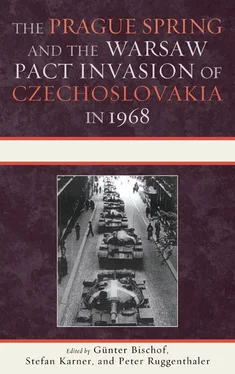This political aim also explains the procedure of coordination regarding the decisions of the CPSU with four of her “sister parties” and the function of the internal conferences. It was imperative to organize and demonstrate closeness in the Warsaw Pact. For the impartial viewer, this is a contradiction in terms; the policies and the military measures decided on were directed against a member state; one of them, Romania, did not participate in these interventionist politics.
By 1968, Moscow was no longer the undisputed leadership center of all Communist parties. Above all, there was the dispute with the Communist Party of China and the two largest western European parties in France and Italy. The response in the Communist world movement to the attempts at reform in Prague was divided. In April, the SED had already specified the differences between the Communists on this matter. 3
The chosen position of the SED regarding the “Czechoslovak events” came about without losing sight of the Moscow line and the internal coordinating conferences. They constituted the breaks during the course of the crisis between the individual phases of its progress.
In Dresden in March, the “Warsaw Five”—the CPSU, the SED, the Bulgarian Communist Party (BCP), the Polish United Workers’ Party (PUWP), and the Hungarian Socialist Workers’ Party (HSWP) who would intervene in Czechoslovakia—brought to an end the phase of interpreting the reforms in the ČSSR as an impending “counterrevolution.” They confronted the delegation of the KSČ with this result. In Moscow in May, the Warsaw Five were concerned with increasing external pressure on the leadership of the KSČ in order to force the abandonment of the reforms. Then, in Warsaw in July, the basic decision to intervene was up for discussion. In Moscow, a few days before the invasion, Walter Ulbricht, Todor Zhivkov, Władysław Gomułka, and János Kádár signed the commitment to involve their states in the intervention. Following the invasion, the politics of restoration and the stationing of Soviet troops in the ČSSR were negotiated in Moscow between the CPSU and the KSČ and voted on by the CPSU in the context of the Warsaw Five. 4
“COUNTERREVOLUTION” IN PRAGUE?
As the year 1968 dawned, First Secretary of the Central Committee of the SED Walter Ulbricht was at the zenith of his power. The borders of the GDR, closed since the construction of the Berlin Wall in 1961, provided for economic planning security; the mass exodus to the West was eliminated. The SED discussed a reform of the direction of the planned economy and a new constitution. The latter was to emphasize inwardly and outwardly the independence of the SED state. The “leading role” of the SED in the GDR received constitutional status and, thus, had to be respected by all citizens and social institutions. The constitution did not give up on the prospect of a united Germany and identified the GDR as the Socialist core state that was to demonstrate to a united Germany what its future development would look like.
With regard to foreign affairs, the GDR had received support at the 1967 conference of twenty-five European Communist parties in Karlovy Vary/Karlsbad for its demand for international recognition as the second German state. In the West and in the noncommitted states, the Federal Republic had prevented this recognition since its founding in 1949. In Karlsbad, the SED received the assurance that in the future no Socialist state would enter into diplomatic relations with the Federal Republic before the latter had recognized the GDR. This agreement was a direct response to Romania entering into diplomatic relations with the Federal Republic. 5
With the support of the CPSU, the SED gained a foreign affairs victory. This support foiled the intention of the new eastern policy of the great coalition in the Federal Republic to isolate the GDR within the Socialist camp.
The change from Antonín Novotný to Dubček at the head of the KSČ in January 1968 did not yet disconcert the SED. The demand made by Ota Šik to introduce a new criterion for legitimating the rule of the Communist Party was presented quietly and did not immediately make it beyond the Czechoslovak border. He demanded in the future “the creation of better living conditions and the solution of the new social contradictions,” and, if the party did not bring this about, the danger existed “that the people would begin to turn their backs on socialism.” In order to prevent this, he demanded that “the Party should give up its monopoly on power” and fundamentally alter the style of party work: “Under current circumstances, it is not possible and also not necessary that the Party directs and controls the entire power and leadership apparatus in detail.” 6With this, he formulated the fundamental idea of the reformers: in the future, the Leninist conception of the party should not legitimate the power of the party; rather, the living conditions of the people under socialism should constitute in the future the yardstick by which its actions would be judged.
The SED leadership did not become alarmed until the developments of the following months: the personnel changes on all levels of the party organization, Novotný’s resignation as state president, the debate on the rehabilitation of the victims of repression at the beginning of the 1950s, and above all the abolition of censorship and, with it, the party’s control over the media.
An important building block for the first chosen positioning of the Central Committee apparatus of the SED in March was the report of the GDR ambassador in Prague. Peter Florin reported the following to East Berlin: 7“The activity of the opposing forces has intensified over recent days and assumes increasingly open counterrevolutionary characteristics.” 8The press, radio, and television were largely in “opposition hands,” and the media were becoming in this way organizers of “counterrevolution.” 9
The keyword for the Marxist-Leninist perception of the dangerous character of the Prague reform politics had been spoken. It was a phrase with a meaning that provided direction. The first sentence of the Soviet black book from August 1968, with which the intervention was justified, was: “The counterrevolutionary line amounted to liquidating the leading role of the KSČ.” 10For the SED ideologues, counterrevolutionary processes in Socialist states under the circumstances of systemic confrontation between socialism and imperialism were always an interaction between “imperialist aggression” from the outside and the emergence of “hostile forces” within the Socialist society. The ideological struggle against the ruling Communist Party was among the most important instruments of “counterrevolution.” 11At the meeting in Dresden, Ulbricht delivered a presentation on the causes of the Czechoslovak crisis with the KSČ delegation in mind. Using the example of the current discussion surrounding freedom in the ČSSR, he lectured on the interplay between the internal and external factors of a counterrevolutionary process. He stressed that the administrative errors made by the KSČ in the past had not been corrected in the framework of the politics of a Marxist-Leninist party, but rather
under the slogan of absolute freedom, the transition from dictatorship to freedom, etc. However, dear friends, you are not alone in Europe. On the western border you have German imperialism. Absolute freedom brings with it several difficulties for you. The opponent is waging psychological warfare. At this moment in time, it would be very costly for you to proclaim absolute freedom. 12
From this point of view, the main “counterrevolutionary” attack was always directed against the Communist Party’s monopoly on power. The GDR ambassador’s report contained a message that was particularly unsettling for the SED leadership: unity within the KSČ leadership no longer existed; an “open” and an “illegal center” were active within it.
Читать дальше












